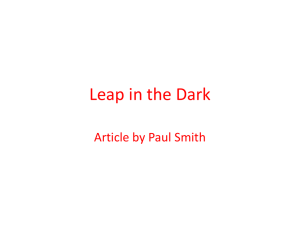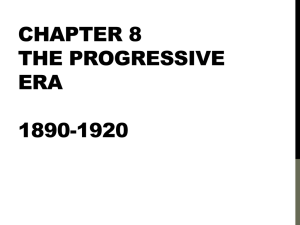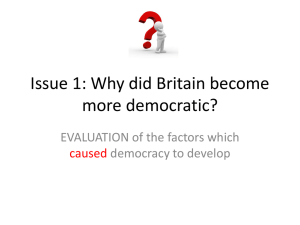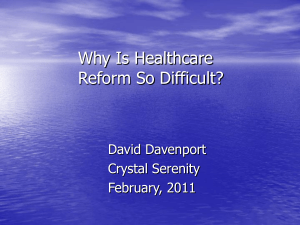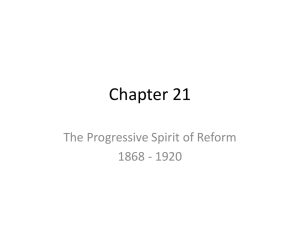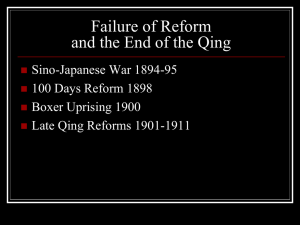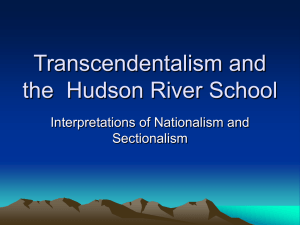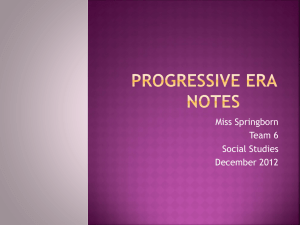File - Beechen Cliff School Humanities Faculty
advertisement
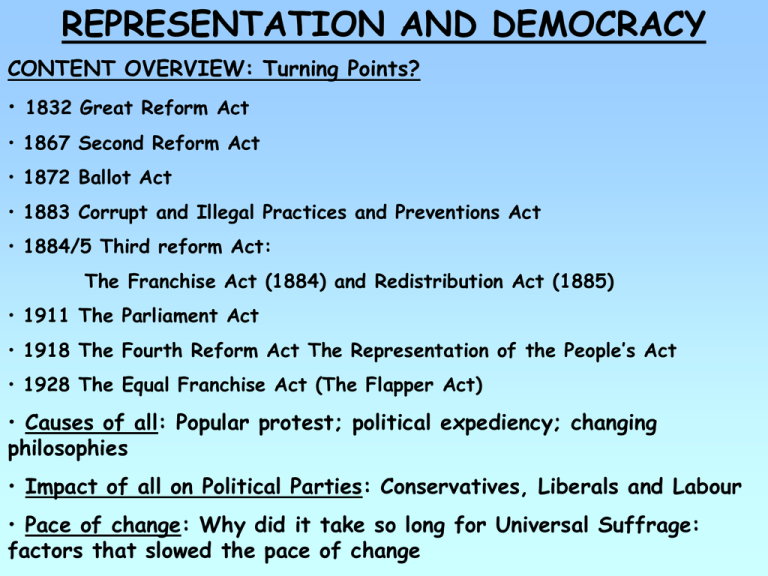
REPRESENTATION AND DEMOCRACY CONTENT OVERVIEW: Turning Points? • 1832 Great Reform Act • 1867 Second Reform Act • 1872 Ballot Act • 1883 Corrupt and Illegal Practices and Preventions Act • 1884/5 Third reform Act: The Franchise Act (1884) and Redistribution Act (1885) • 1911 The Parliament Act • 1918 The Fourth Reform Act The Representation of the People’s Act • 1928 The Equal Franchise Act (The Flapper Act) • Causes of all: Popular protest; political expediency; changing philosophies • Impact of all on Political Parties: Conservatives, Liberals and Labour • Pace of change: Why did it take so long for Universal Suffrage: factors that slowed the pace of change REPRESENTATION AND DEMOCRACY THE ACTS: WHAT CHANGED AND WHAT STAYED THE SAME? 1832 THE GREAT REFORM ACT CHANGES F FRANCHISE C CORRUPTION U UNCONTESTED/ CONTESTED ELECTIONS K CONSTITUENCIES 1 in 5 could now vote – nearly doubled to 800,000 8% of electorate could now vote Boroughs – Middle Classes gained the vote under the £10 householder franchise Counties – Tenant farmers also joined Some rotten boroughs were removed An electoral register was introduced PRESERVED Working classes could not vote – in fact fewer working class eligible to vote after 1832 than before (abolition of potwalloper etc) Plural voting still occurred Women could not vote No change to corruption of elections: remained ‘open’, bribery continued and became more visible, no limit to election spending and in 1841 election votes were sold. The number of contested elections rose above 38% First election after GRA 74% of elections were contested Average 1832-65 = 59% contested elections 22 new boroughs with 2 seats each were created 20 new parl boroughs with 1 seat each created 56 smallest boroughs lost both seats 30 small boroughs lost 1 seat each County representatives in Parl increased There remained small towns that retained representation After 1832 over 60 constituencies had fewer than 300 voters Industrial areas and the N of England still under represented The S over -rep OVERALL: Middle class in boroughs and tenant farmers in counties gained but vulnerable to eviction if voting outside landlord’s wishes. Pocket boroughs, aristocratic patrons, violence and intimidation remained. REPRESENTATION AND DEMOCRACY THE ACTS: WHAT CHANGED AND WHAT STAYED THE SAME? 1867 THE SECOND REFORM ACT CHANGES F FRANCHISE C CORRUPTION 1 in 3 could now vote an increase of c. 700,000 Boroughs – male householders 1 yr residency ‘Compounders’ lodgers paying at least £10 rent Counties – owners or leaseholders of land of a yearly value of £5 or more or had rateable land of £12 per year. 7 towns disfranchised for corruption U UNCONTESTED/ CONTESTED ELECTIONS K CONSTITUENCIES PRESERVED 1 yr residency = 40% w/c males could still not vote Counties – 40shilling freeholder still existed Plural voting still occurred Women could not vote House of Commons still dominated by landowners No change to corruption of elections Little change 45 seats taken from boroughs with under 10,000 inhabitants 7 towns disfranchised for corruption 25 seats given to counties 20 seats created for new boroughs 6 boroughs gained 1 extra seat London Uni given a seat London, Midlands and North still underrepresented Rural south still over represented E.g. S West = 76,612 electors = 45 MPs N East = 232,431 electors = 32 MPs OVERALL: For the first time the overall electorate contained a majority of working class voters, although its effects were minimalised as a result of the distribution which still favoured counties. REPRESENTATION AND DEMOCRACY THE ACTS: WHAT CHANGED AND WHAT STAYED THE SAME? 1872 THE BALLOT ACT CHANGES PRESERVED • Voting became secret • A cross was placed next to your choice and placed in a ballot box • Corruption still existed and in fact became worse as voters could now take bribes from both sides 1883 CIPPA CHANGES • Corrupt Practices such as treating, bribery, ‘undue pressure’, abducting and impersonating were banned and punishable with imprisonment and fines • Limits were set on election expenditure and accounts had to be kept. PRESERVED REPRESENTATION AND DEMOCRACY THE ACTS: WHAT CHANGED AND WHAT STAYED THE SAME? 1884/85 THE REFORM AND REDISTRIBUTION ACTS F FRANCHISE 1884 CHANGES PRESERVED Gave the vote to male householders and £10 lodgers in the counties (on ‘tenements’) (1 yr Residency clause) £10 occupation franchise to those who owned shops/offices Counties were given the same franchise extension that the boroughs had in 1867 Many working class men (as a result of 1 yr residency clause) and all women could still not vote. C CORRUPTION Corruption dealt with in 1883 U UNCONTESTED ELECTIONS K CONSTITUENCIES (REDISTRIBUTION) 1885 Elections more contested as a result of reduced corruption 160 seats redistributed 79 Boroughs under 15,000 lost 1 seat each London Constituencies increased from 22 – 55 Other Cities and Counties gained seats Old County divisions were cut into single member constituencies No longer Communities but ‘units’ based on numbers Universities still had seats Some imbalance still existed between constituencies. OVERALL: Householder franchise became the main means by which men qualified to vote (1911 84% of men registered under it) Redistribution was massive and the attempt to address the problems of unbalanced constituencies was probably the most important aspect of these reforms. REPRESENTATION AND DEMOCRACY THE ACTS: WHAT CHANGED AND WHAT STAYED THE SAME? 1918 THE FOURTH REFORM ACT: THE REPRESENTATION OF THE PEOPLES ACT CHANGES F FRANCHISE Universal male suffrage (reduced residency qualification) Women over 30 who were householders or had husbands who were householders All men of 19 and above that were in active service during the war could also vote C CORRUPTION Women under 30 could not vote 5% of adult males did not register to vote Plural voting still continued Corruption dealt with in 1883 U UNCONTESTED ELECTIONS K CONSTITUENCIES PRESERVED Elections more contested as a result of reduced corruption Cheaper as ‘returning officer’ was paid by the state Remaining smaller parl boroughs lost their seats Most became single-member constituencies of about 70,000 inhabitants Some constituencies became predominately ‘working class’ or ‘middle class’ constituencies Universities still had seats Some imbalance still existed between constituencies. OVERALL: Electorate was increased by over 5 million men and 8 million women Single-member constituencies roughly created of about 70,000 inhabitants THE EQUAL FRANCHISE ACT – THE ‘FLAPPER’ ACT OF 1928 •Women over the age of 21 were given the vote on the same terms as men. THE PARLIAMENT ACT 1911 Throughout the 19th Century the Lords had power of veto over legislation passed by the Commons. •The Lords were hereditary •The Commons were elected Therefore, the ‘Lords’ was an obstacle to democracy, especially in the eyes of radicals. Some radicals were interested in its abolition –remember they had tried to block the 1832 Reform Act. There was a permanent Tory/Conservative majority in the House of Lords. 1906 – A Liberal Government was elected by a landslide victory and wanted to carry out an extensive social reform agenda. They had trouble with the Conservative dominated Lords. 1909 – Major clash over the budget put forward by Lloyd George, the Chancellor of the Exchequer, who proposed more tax on the wealthy to finance the reforms e.g. OAP scheme. The Lords rejected the budget, which was unheard of before. There was an unwritten agreement that the Lords never interfered with financial matters. The Liberal Government, led by Asquith decided to take the Lords on: The authority of the elected house had been challenged therefore the Government attempted to reduce the power of the Lords. The power of the Lords was not an issue in the 1906 election, therefore Asquith held an election in 1910 to seek a mandate from the electorate. The Liberals lost their overall majority but stayed in power because of Labour MPs and the Irish. THE PARLIAMENT ACT 1911 The Parliament Bill- was introduced to: •Remove the power of veto •Replace the veto with the power of delay up to 2 years for non-financial bills •No power over financial bills •The period between elections was reduced from 7 to 5 years The King was asked to create enough new peers to swamp the Tory majority in the Lords (remember Grey in 1831/32), but the King was reluctant. He wanted another General Election instead before he would finally agree. 1910 – December election had a very similar result, but the King did agree to create new peers to push the bill through, as the ‘lesser of two evils’. The Bill became ‘The Parliament Act’. It was limited reform. It could have gone further and have questioned the undemocratic right of hereditary peers to sit in the Lords, or it could even have got rid of the Lords altogether. It was ultimately more conservative as limited reform was thought to be sufficient at the time, even though it would have been more democratic to go further. THE DEVELOPMENT OF THE LABOUR PARTY PRE-WAR Most working class men could not vote until 1867 and 1884/5 1885 – Redistribution of seats helped Labour. It created 89 Constituencies which had a clear majority of working class electors. Many were targeted by the Labour Party in early attempts to gain seats. E.g. Mining areas, cotton and woollen towns and E. End of London. But this was not always successful as a result of ‘Lib-Labism’ e.g. miner’s union from 1870s were sponsoring MPs under the Liberal Party. 1892 – Keir Hardie was the first Independent Labour MP elected for West Ham. But progress was slow, he was defeated in 1895 but re-elected in 1900 with a Labour Representation Committee Member. 1893 – ILP – the Independent Labour Party was formed after pressure for a Party to represent working classes, led by Keir Hardie. 1895 – ILP did badly in the elections. 1900 – Growing Trade Union support. The Labour Representation Committee was founded with TUs playing a key role to work for the establishment of a Labour group in parliament. 1903 – ‘Lib-Lab’ Pact – Gladstone (lib) and Ramsay Macdonald (secretary of the LRC) agreed they would not put up candidates against each other as they did not want to split the anti-Conservative vote. 1906 – As a result of the ‘Lib-Lab’ Pact in the 1906 elections 29 LRC (Labour) candidates were elected. 1910 – Miner’s Unions switched support to Labour – 42 Labour MPs were elected. So, before the war, Labour had difficulty in building up support. Of the 40% of male adults that still could not vote, most showed no signs of supporting ‘radical’ Labour. Instead the Party’s strengths lay in Industrial areas, therefore they were appealing to the same skilled and politically conscious members of the population as the Liberals. THE DEVELOPMENT OF THE LABOUR PARTY POST WAR. 1918 – The Representation of the People Act. Full adult suffrage was a benefit to Labour in the Long Term, but not immediately. Representation of Labour in the Commons was not significantly different to that of 1910. So, there is no automatic correlation between extending the franchise and increasing the Labour vote. But, Labour was more effective at taking advantage of new opportunities presented by the new electoral system. 1918 – A new party structure was introduced – the LRC with a loose alliance with the ILP was not as effective. The ‘new’ Labour Party had individual membership in constituency parties, linked by strong central organisation (but constituency parties not fully established until 1923). Women’s sections drew support. Labour was also more effective at propaganda, with mass rallies, public meetings and poster campaigns. They made essential links with the Trade Unions as Union Membership had grown throughout the war. Conservative and Liberal Governments had failed to deal with unemployment. So, the Conservatives and Labour took advantage of the ‘first-past-the-post’ electoral system. 1920s – the Liberals found themselves the 3rd party and losing out in both the countryside (to the cons) and Industrial Towns (to Lab). The Liberals acquired the image of a party in decline. Middle Class Liberals converted to the Conservatives Working Class Liberals converted to Labour CAUSES OF CHANGE THE ROLE OF POPULAR PROTEST THE GREAT REFORM ACT 2ND REFORM ACT SECRET BALLOT AND CIPPA 3RD REFORM ACT 4TH REFORM ACT PROTEST - Econ probs fuelled discontent in 20s - 1816 Spa Fields, 1817 March of the Blanketeers, 1817 Pentridge Rising, 1819 Peterloo Massacre, 1820 Cato St Conspiracy, Swing Riots 1831, riots in Bristol after failed franchise bill. - Econ downturn in 1860s = increased unrest - Hyde Park Riots July 1866 - Trade union outrages in Sheffield 1866 - increasing demands for reform from all classes - increased violence during elections - Miners in counties e.g. Northumberland and Durham campaigned for Libs in 1874, some violence - Riots were relatively small and few - Suffragettes violent action particularly against property FEAR - Fear of revolution like France - Fear of w/c violence led to double agents to uncover any plots - Middle classes also feared the w/c would get the vote and not use it wisely - PM Liverpool tried repressive policies 1812-27 and it didn’t seem to work - less fear of w/c as the skilled became more affluent, but it still existed - violence at elections led to fear of it escalating out of control - less fear here as w/c in the counties were asking for the same terms as the boroughs - prior to war feared women would not use vote wisely as they were ‘irrational, emotional and weak’ less fear after war CAUSES OF CHANGE THE ROLE OF POPULAR PROTEST THE GREAT REFORM ACT 2ND REFORM ACT PRESSURE GROUPS - Radicals e.g. Paine, Wade, Hunt, Cartwright, Cobbett - Corn Law interest groups - Hamden Clubs – forums for political discussion - Dissenters – nonconformists - Husskissonites – wanted reform and supported Home Rule - Reform Union – middle class - Reform League – Working class - Chartists - Individuals e.g. Gladstone WAR - Napoleonic War increased fear in Britain and led to repressive policies - 1848 Revs in Europe were feared in Britain and calls for change were made SECRET BALLOT AND CIPPA 3RD REFORM ACT 4TH REFORM ACT - Chartist demands for a secret ballot - Miners in N counties - Radicals in 1883 holding meetings to gain support - Suffragists (National Union of Women’s Suffrage Society) under Millicent Fawcett - Suffragettes (Women’s Social and Political Union) under Emmeline Pankhurst - First World War. Women’s contribution to the war effort led to female suffrage CAUSES OF CHANGE THE ROLE OF POLITICAL EXPEDIENCY TORIES/ CONS. THE GREAT REFORM ACT 2ND REFORM ACT SECRET BALLOT AND CIPPA 3RD REFORM ACT 4TH REFORM ACT - After 1830 the Tories lost power over splits within the party (Liberals and Ultras) over Catholic Emancipation under Liverpool’s Government - 1830-33 unity disintegrated and policy direction was lost - They opposed the Whig’s Reform proposals - Disraeli’s Bill of 1867 was introduced to exploit the differences within the Liberal Party. They were keen to find a way to gain favour with the public. - Disraeli and the Conservatives took credit for reform and expected to gain votes as a result - They had cooperated with the Adullamites to defeat the ‘moderate’ Liberal Bill and then introduced a more extreme one. - It was a ‘Leap in the Dark’ as the skilled artisans were usually Liberal but the Conservatives hoped they would vote for them instead - Both Parties supported the idea of a reduction of corruption as it would benefit both in terms of reduced election expenses. - Salisbury hated reform but believed that redistribution would benefit the Conservatives. - Extension of the Franchise wouldn’t benefit them so they needed the balance with redistribution. - The Arlington Street Compact was the agreement reached which gave the Conservatives redistribution. - The ‘Primrose League’ had actively involved women in elections and the conservatives had done more than any other party to involve women at local level. They therefore believed that women over 30 would vote Conservative. However, Conservative backbenchers still did not want to give women the vote. CAUSES OF CHANGE THE ROLE OF POLITICAL EXPEDIENCY WHIGS/ LIBERALS THE GREAT REFORM ACT 2ND REFORM ACT SECRET BALLOT AND CIPPA 3RD REFORM ACT 4TH REFORM ACT - Lord Grey led the Government from 1830. He was keen on reform to keep power. Wanted both redistribution and extension of the franchise. - Many Whigs were from the Middle Classes - They took advantage of the disarray of the Tories - The Liberals were in disarray as Palmerston’s supporters refused to join the Government which provided a real opportunity for the Tories. - Gladstone believed in the moral case for reform and initially brought in the first bill which extended franchise to £7 householders which was defeated by the Tories, which led to a further split. - Palmerston’s death in 1865 signalled a new era as he had been resolutely against reform - See above - Gladstone needed radical support to push reform through and appointed Bright t his cabinet 1868-1874. - Jo Chamberlain called for a new Liberal Radicalism in the aftermath of the Irish Issue. He called for a Radical Programme of social reform and greater powers for local Gov. - Gladstone was less radical and believed 1867 Act had created an imbalance that needed to be rectified. He saw the extension of the Franchise in the Counties as benefiting the Liberals as the 2nd Reform had done in the boroughs. - Arlington Street Compact was the compromise reached with the Tories - Asquith had failed to bring in the Conciliation Bill of 1911 which had led to an increase of suffragette militancy. However, the backbench Liberals were more in favour of women’s suffrage than the Conservatives - Women left Lib Party in 1886 in protest of lack of reform - The Women’s Liberal Federation 1887 appeased women - Lloyd George introduces Representation of the people’s Bill due to women’s contribution during the War. He had always been in favour of female suffrage. CAUSES OF CHANGE THE ROLE OF POLITICAL EXPEDIENCY THE GREAT REFORM ACT RADICALS/ LABOUR - Individual Radicals pushing for reform e.g. Cobbett, Hunt, Paine - but not a party at this time. 2ND REFORM ACT - Pressure from the Left e.g. radicals like John Bright, Foster and Stansfield. SECRET BALLOT AND CIPPA 3RD REFORM ACT 4TH REFORM ACT - See above Radicals believed they would gain if the vote was secret and therefore pushed for both reforms - The Radicals were trying to control the Liberal Party after Bright had been taken into the Cabinet. Chamberlain also had a lot of support - The New Labour Party was developing along with Trade Unions as the newly enfranchised working classes needed a new party to suit their interests. - The new Labour Party was increasing in influence and the NUWSS supported Labour with a fighting fund and the Liberals lost out as a result. - The Labour Party took the advantage in supporting female suffrage in the hope the newly enfranchised women would vote for them. CAUSES OF CHANGE THE ROLE OF CHANGING PHILOSOPHIES MIDDLE CLASSES THE GREAT REFORM ACT 2ND REFORM ACT SECRET BALLOT AND CIPPA 3RD REFORM ACT 4TH REFORM ACT - With the Industrial Revolution many of the Middle Classes became incredibly wealthy. They therefore held an economic stake in the country and became closer to the aristocracy than ever before. - The GRA was a reform intended to preserve aristocratic power - The Middle Classes with their new money was seen as safe and indeed once they had the vote they were as guilty as the aristocracy in helping to preserve the old order. - They had caused no problems or changes to the balance of power as a result of the GRA and therefore led to a changing attitude towards reform in general. - no problems since GRA - no problems since - no problems since GRA - some Middle Class MPs the GRA CAUSES OF CHANGE THE ROLE OF CHANGING PHILOSOPHIES WORKING CLASSES THE GREAT REFORM ACT 2ND REFORM ACT SECRET BALLOT AND CIPPA 3RD REFORM ACT 4TH REFORM ACT - They were not educated and were seen as dangerous especially as they were growing in number as a result of the population explosion - Many believed they should accept Gentry rule and be humble - Liverpool had quelled any potential violence thoroughly using force - However, they were growing more politically aware - The use of ‘the Reform League’ increased their standing - The Government feared it was dangerous not to concede to them as a result of the Hyde Park Riots - Gladstone was impressed by the more affluent skilled workers who worked hard, saved money and who believed in sobriety and religious morality - They still believed the ‘Residuum’ was corrupt, uneducated and undeserving of the vote. - Politicians feared violence at elections through drunkenness and treating. - The skilled artisans in the Boroughs had not caused any problems since 1867 Act. It appeared there was an unfair imbalance in the franchise and that skilled workers in the counties were ‘safe’ to enfranchise. - They were seen as a low risk group to have the vote - They had also become more organised in protests e.g. the Miners and Tom Burt MP - The War was the key factor here. If soldiers returning from war could not have the right to vote due to the 1 year residency clause there would be mass protests. - Almost all politicians were in support of changing the 1 year residency clause as a result. CAUSES OF CHANGE THE ROLE OF CHANGING PHILOSOPHIES THE GREAT REFORM ACT WOMEN - Separate ‘spheres of influence’ - Lots of politicians against women’s suffrage e.g. Gladstone, Bonar Law, Asquith. Even Queen Victoria opposed it. 2ND REFORM ACT - As before SECRET BALLOT AND CIPPA - As before 3RD REFORM ACT - They were expected to be included in reform and they were shocked when they weren’t. 4TH REFORM ACT - Suffragists were respected by many politicians - Suffragettes were generally not respected by politicians, but did keep the idea of female suffrage in the public eye. Perhaps hindered progress of female suffrage. - The War changed the overall opinions of women – they were seen to be reliable and dependable as a result of their war efforts CAUSES OF CHANGE THE ROLE OF CHANGING PHILOSOPHIES IDEA OF REFORM THE GREAT REFORM ACT 2ND REFORM ACT SECRET BALLOT AND CIPPA 3RD REFORM ACT 4TH REFORM ACT - Catholic Emancipation had proved that reform may not be as dangerous as first feared. - Politicians were divided – some thought that reform was necessary to prevent violence – whereas others thought it would cause violence. - Interest in Italian Unification and US Civil War increased demands for change at home. - Attitudes were becoming more flexible to change. - Reformers had called for a secret ballot since the 1770s - Elections of 1868 were very violent and corrupt = committee of enquiry - Society was generally less violent and brutal and more politically conscious - Politicians came to expect further change and to even out the differences between the counties and boroughs - War made reform necessary for both men and women. - By this time the franchise was extended with few criticisms or hassle. IMPACT OF REFORM ON POLITICAL PARTIES THE GREAT REFORM ACT IMPACT ON POLITICAL PARTIES IN GENERAL: There continued to be loose party unity and the ‘Whig’ and ‘Tory’ labels were attached to groupings of politicians As a result of the abolition of rotten boroughs patronage declined Party organisation at local and National Level therefore became more important Voters had to be registered as a result of the GRA and this made organisation even more essential. TORIES: Established the Carlton Club in 1832 which was the first Central Organisation Knew that if they remained a party of Anglican Landowners they would not survive with the new Middle Class Voters and the new boroughs in the Industrial towns Radicals under Oastler wanted an alliance with working class but this wasn’t acceptable by the majority Peel wrote the Tamworth Manifesto of 1834 he said he accepted the GRA but saw it as the last reform of the ‘Constitutional Question’, but did admit they were prepared to look at Middle Class grievances and perhaps reform them. But reasserted Tory belief of tradition and respect. This was the first Conservative Manifesto which set out new principles for the party The party continued to resist whole sale changes to established institutions like the church and monarchy but were prepared to consider cautious and limited change if necessary WHIGS: Founded their National Headquarters the Reform Club in 1836 Through tactical necessity the Whigs under Lord Melbourne made an alliance with the Irish and the Radicals to get rid of Peel’s new conservative Government called the Lichfield House Compact. It was only intended to be short-term but ended forming the basis of the Victorian Liberal Party OVERVIEW: GRA led to politics becoming dominated by the two major parties: Conservatives and the Liberals Newspapers began to report election results in Liberal or Conservative gains for the first time Manifestos, National Headquarters, and local organisations were set up for the first time IMPACT OF REFORM ON POLITICAL PARTIES THE GREAT REFORM ACT COMPOSITION OF PARLIAMENT AFTER ACT: Over 70% of MPs were aristocrats Less than 22% of MPs were middle-class businessmen No working class MPs Of the 8 PMs 1832-65 only Sir Robert Peel came from non-aristocratic background (but privately educated) Most ministers were aristocrats WHY? Middle Classes still voted for their ‘social superiors’ Aristocrats had time to attend parliamentary debates Up to 1858 county members had to have land - £600 and borough members had to have a £300 estate MPs did not earn a salary IMPACT OF REFORM ON POLITICAL PARTIES THE SECOND REFORM ACT OUTCOME OF ELECTIONS: 1868 – Liberal win 1874 – Conservative win 1880 – Liberal win 1868 – Liberal win and Disraeli resigns. Why significant? Now he recognised the electorate were more important than the patronage of the King. Previously only the King dismissed and appointed Prime Ministers. Disraeli was almost ignoring this tradition by recognising the importance of the election result. 1880 – ‘The first Modern Election’? 84% seats were contested Gladstone’s ‘National Campaign’ – the first leader to ‘tour the country’ and canvass votes Clear cut policies of the two parties for the first time: Disraeli’s Conservatives: ‘foreign and imperial policy based on national self-interest and military expansion’; or Gladstone’s Liberals: ‘Moral principals and conciliation of foreign power’. IMPACT OF REFORM ON POLITICAL PARTIES THE SECOND REFORM ACT EFFECTS IN GENERAL: Party discipline tighter through the use of ‘party whips’. Longer parliamentary sessions. Governments suffered fewer defeats in debates. More organised at constituency level Propaganda and persuasion took the place of influence and patronage. Supporters were registered as voters and many contested 1 yr residency stipulation. LIBERAL PARTY: The Liberal ‘Caucus’ (after Disraeli’s clause of 2 votes for 3 MPs) In Birmingham Joseph Chamberlain countered this measure by identifying Liberal supporters and telling them which candidates to vote for to keep the Conservatives out. This was so successful that it was copied elsewhere in the country. The Liberal Registration Association set up in 1860 In 1877 the new ‘National Liberal Federation’ (NLF) was set up to adopt the Birmingham caucus methods elsewhere. This was the attempt by ‘rank and file’ Liberals to radicalise and to establish democratic control over the party’s leaders. THE CONSERVATIVES: 1867 the ‘National Union of Conservative Constituency Associations’ (NUCCA) was set up to organise conservative working class voters. This brought working men’s clubs under its jurisdiction as well. Its first ‘Annual Conference’ was held in 1868. The Conservative ‘Central Office’ was created by John Gorst to encourage new constituency associations, maintained contact with local parties and drew up lists of candidates. IMPACT OF REFORM ON POLITICAL PARTIES THE SECOND REFORM ACT THE CONSERVATIVES: 1867 the ‘National Union of Conservative Constituency Associations’ (NUCCA) was set up to organise conservative working class voters. This brought working men’s clubs under its jurisdiction as well. Its first ‘Annual Conference’ was held in 1868. The Conservative ‘Central Office’ was created by John Gorst to encourage new constituency associations, maintained contact with local parties and drew up lists of candidates. HOW DID THE LIBERALS APPEAL TO WORKING CLASS VOTERS? Operatives Liberal Associations – arranged annual outings, social activities, ‘Burial funds’ and political education of their working class supporters to gain their long-term support. The majority of the new working class voters were Liberal as they were impressed by their policies of free trade, low taxation, reform of education and limited franchise reform Gladstone tried to cooperate with the Trade Unions but with limited success. HOW DID THE CONSERVATIVES APPEAL TO WORKING CLASS VOTERS? Conservative Working Men’s Associations involved drinking, billiards, brass bands, football teams, sickness and burial funds and political education. 1/3rd of working class men consistently supported the Conservatives after 1867 especially in Liverpool, West Lancashire, Birmingham, West Midlands and the East End of London. WHY? – because of deference, patriotism, dislike of foreigners, Liberal weaknesses and Conservative policies. IMPACT OF REFORM ON POLITICAL PARTIES THE BALLOT ACT 1872 AND CIPPA 1883 IN GENERAL: Parties needed more professional election agents who knew the Law. (A result of bribery being punishable by fines, imprisonment or loss of seat). Parties needed more volunteers who could undertake the more mundane work. (A result of limits to election expenses) THE LIBERALS: The liberals had a large number of volunteers. However, the Liberal decline (split over Irish home rule) - after 1886 meant they were difficult to hold on to. The traditional ‘whigs’ tended to ally with the Conservatives. To get back into power ‘New Liberalism’ ensured a landslide victory in 1906 but faced another split in 1916. LABOUR (Less important as a short-term consequence of the 1880 reforms, but they did have an impact in the longer term): 1900 the Labour Representation League was founded and worked with the Trade Unions. This was in response to the working classes getting the vote in 1867 and 1884, but also as a result of secret ballot and CIPPA as the working classes could now use their vote as they wanted to. Therefore a working class party was now called for. This eventually led to 29 Labour MPs being elected in 1906 under the ‘New Labour’ Party (although Liberals kept them in check through the Lib-Lab pact). IMPACT OF REFORM ON POLITICAL PARTIES THE BALLOT ACT 1872 AND CIPPA 1883 THE CONSERVATIVES: Reacted more to the reforms of 1880s than any other party. The ‘Primrose League’ was founded in 1883. This recruited party volunteers. It promoted the church, landed classes and the Empire. It was founded by Lord Randolph Churchill and named after Disraeli’s favourite flower (Disraeli was elevated to a Tory icon). It rebuilt the Tory Party as a ‘True Union of the Classes’ Male members were called ‘Knights’ and females ‘Dames’. Branches were called ‘Habitations’ It was incredibly successful: In 1886 there were 237,000 members; in 1891 there were over 1 million members and in 1910 there were over 2 million members. The League organised social activities and over half its members were women. The League proved to be an ideal organisation to encourage popular participation in the Conservative Party, without actually involving the ‘rankand-file’ members in decision making. Therefore all decisions remained with the Tory Leaders. IMPACT OF REFORM ON POLITICAL PARTIES THE THIRD REFORM ACT - THE FRANCHISE ACT 1884 IN GENERAL: Farm Labourers gained the vote in 1884 and forced parties to develop new ways of reaching rural voters. Conservatives tended to do best in the countryside but no party was taking this for granted especially after the Secret Ballot Act. THE LIBERALS: The Liberals had been largely an Urban political force apart from when Liberal Landowners had secured votes in their communities. They had to rely on ‘political missionaries’ from the towns to carry the radical message to the country villages. Mobile vans bringing speakers, leaflets and lantern shows were sent to the countryside by political organisations such as the ‘Land Nationalisation Society’ and the ‘Land Restoration League’. Cycling clubs were also popular. The Liberals did give more attention to Rural issues after 1884. Radical Liberals believed that farm labourers would need economic independence through small farm holdings, if they were to use their vote independently. Leaders like Joseph Chamberlain therefore talked about ‘land reform’ in his ‘Unauthorised Programme’ of 1885. In this he called for labourers to get smallholdings (dubbed “Three Acres and a cow”). His proposals were rejected by Gladstone but rewarded in the 1885 General Election where the Liberals made gains. THE IMPACT OF REFORM ON POLITICAL PARTIES THE THIRD REFORM ACT – THE FRANCHISE ACT 1884 THE CONSERVATIVES: Conservatives did traditionally have a stronger hold in the countryside – but even they were not complacent. Primrose League ‘Dames’ could combine exercise with political missionary work by joining the Primrose Cycling Corps. The Conservatives also introduced a number of reforms focusing on rural issues (landholding and local government) in 1886. Elected county councils were introduced in 1888 – a concession to democratic principles. They also introduced the Allotments Act in 1887 and a Smallholding Act in 1892 under which local councils could purchase land and lease it in small plots to earn rent. LABOUR: The Labour Party was now beginning to emerge in the 1890s as for the first time the working classes were in the majority of voters in some areas. They also tried to appeal in the counties by using cycling clubs – theirs was called the ‘Clarion Cycling Club’, especially popular in Northern industrial areas. IMPACT OF REFORM ON POLITICAL PARTIES THE THIRD REFORM ACT – THE REDISTRIBUTION ACT 1885 IN GENERAL: Redistribution meant that for the first time single-member constituencies were established. This was to have far-reaching consequences for both the Conservatives and the Liberals. THE WHIGS AND LIBERALS: An unforeseen consequence was that the Whigs suffered serious damage. Most Whigs had broken with the Liberal Party in 1886 over the issue of Home Rule and many stood as Independent candidates or defected to the ‘Liberal Unionists’. Previously, in large urban constituencies that had returned 2 or 3 MPs the Whigs had shared the vote with the Liberals. In single-member constituencies this no longer happened and the Whigs didn’t get voted in as they were seen to be too radical. Liberal MPs were voted for instead. THE CONSERVATIVES: The Conservatives made significant gains of seats in the large urban areas in elections after 1885. Salisbury had insisted on a Redistribution Act because the Conservatives had been gaining ground among the middle classes in the suburbs since 1874 (so called ‘VillaToryism’). If single-member constituencies were created that divided towns along class lines then the Tories could convert votes into seats. One of the major factors in the electoral success of the Conservative Party 1886-1906 was its ability to win extra seats in the former Liberal heartlands of Industrial areas. THE IMPACT OF REFORM ON POLITICAL PARTIES THE THIRD REFORM ACT – THE REDISTRIBUTION ACT 1885 THE LABOUR PARTY: The Redistribution Act created 89 constituencies which had a clear majority of working class voters. Many of these were targeted by the Labour Party in the early attempt to win seats. (E.g. Mining areas, woollen towns and the East End of London) SHORT-TERM CONSEQUENCES: However, their success was often hindered by the Trade Unions who were still dubious of the new Party and instead continued to sponsor working-class candidates to stand under the Liberal Party – ‘Lib-Labism’. It was not until 1909 that the unions decided to affiliate to the Labour Representation Committee. Labour was also hindered by the fact that a large portion of the working class could still not vote after the franchise extensions of 1867 and 1884. (1 Year Residency clause). The first Independent Labour MP elected was Keir Hardie in 1892 and after that it remained a slow process. LONG-TERM CONSEQUENCES: After 1900 with increasing trade union support and the signing of the ‘Lib-Lab’ Pact (the Liberals and Labour agreed not to split the anti-conservative vote by standing against each other), the LRC began to make significant breakthroughs. In 1906 29 LRC candidates were elected. 1909 Miner’s Unions switched support from Liberal Party and in 1910 42 Labour MPs were elected. However, before 1914 the Labour Party did not pose a serious threat to the Liberal Party. Labour’s strengths lay in the Industrial areas. But generally they were appealing to the same groups of voters that the Liberals were. IMPACT OF REFORM ON POLITICAL PARTIES THE THIRD REFORM ACT 1884-5 HOW DID THE COMPOSITION OF THE HOUSE OF COMMONS CHANGE? Gradual reduction of landowning MPs increased after 1885. Less Liberal MPs were now landowners (only 7% by 1910) Liberal Middle Class MPs had increased from 67% to 89%. The pace was slower with the Conservatives. Landowners still made up 38% of the party in 1900. In 1910 this was still 26%. It was not until 1911 that a leader was chosen that was Middle Class. The first working men to be elected to the Commons under Lib-Labism was in 1874.Until 1885 this did not rise above 2. But, the Radicalisation of the Liberal Party after 1886 and the growths of the unions this had risen to 12 by 1895. 1906 was the first marked increase with 29 Labour MPs and 24 Lib-Lab MPs. Overall the Commons still had a ‘gentleman’s club’ feel to it. IMPACT OF REFORM ON POLITICAL PARTIES THE FOURTH REFORM ACT 1918 IN GENERAL: The Act radically changed the electorate which now meant working classes were in the majority. It also radically changed Redistribution. Parties now had to appeal to this new mass electorate. LIBERALS: The split in the Liberal Party in 1916 really affected efforts to curtail Labour’s threat. Lloyd George continued his ‘Coalition Government’ with the Conservatives until he was ditched in 1922. Asquith attempted to maintain an independent Liberal Party in opposition to Lloyd George. They reunited in 1923 but by then the damage was irreparable. In 1929 the Party only won 59 seats. CONSERVATIVES: The Conservatives were the most successful party 1918-31 and were in office for 10 of the 13 years. Conservative strength was at least partly due to the divisions between Asquith’s Liberals, LloydGeorge’s Liberals and Labour. Conservatives gained as a result of redistribution. The growth of suburban area seats definitely helped the Conservatives. Granting of votes to women over 30 was on balance more favourable to the Conservatives than the other two. They had taken care to cultivate women voters. Many of the new working class voters also voted Conservative. Probably most important though was that the Conservatives adapted its organisation more effectively than the others to turn opportunities into achievements. The Conservatives had a large mass membership which gave them an army of volunteers. Particularly successful in involving women who were given active roles in canvassing. By the late 1920s the Conservatives had over 1 million women members. IMPACT OF REFORM ON POLITICAL PARTIES THE FOURTH REFORM ACT 1918 CONSERVATIVES: continued They also had an efficient Party Organisation ensuring all campaigns were run professionally. It had more full time agents than the others. They could also identify their supporters and get them to the polling booths. It was also able to adapt its policy to the changed complexion of the electorate and embrace more positive social reforms. LABOUR: Labour only made modest gains in the short-term. But the creation of more constituencies in the Industrial areas did benefit them because this was their main area of support. They did take better advantage of the changed electoral system than the Liberals. 1918 saw a new Party structure. The new Labour Party had individual membership in constituency parties and a strong central organisation. Women’s sections drew female supporters to the party. They held effective propaganda campaigns e.g. mass rallies and poster campaigns. Links with the Trade Unions were essential financially and in reaching a mass electorate. They also exploited the failure of the Conservative and coalition Governments to deal with unemployment. They also took advantage of the ‘first-past-the-post’ electoral system and eventually became the ‘second party’ at the expense of the Liberals. WHY DID IT TAKE SO LONG TO ACHIEVE UNIVERSAL MANHOOD SUFFRAGE? 1.The desire of the Ruling Elite to maintain their power: The Great Reform Act was a product of Whig opportunism against their Conservative opponents and a need to quieten the forces of change. The limited franchise of the middle classes doubled the electorate but advanced the numbers who could vote to a mere 6% of the adult population. The Act achieved its purpose. Middle class leaders were brought into the system and were divorced from the masses. Moreover, this was achieved at little cost to the old order. Little was altered. Corruption remained rife. Rotten boroughs and Pocket boroughs continued. The essential safeguards of true democracy, a secret ballot and punishment for corruption, weren’t introduced until 1872 and 1883 respectively. Representation remained unequal between north and south, town and shire. The ruling elite had maintained its position at little cost. Throughout the next 100 years, concessions were made only when they had to be made and, until 1918, the elite believed that they would concede no more. The domination of old Whigs such as Palmerston ensured no reform before 1867 (he died in 1865) and Salisbury viewed the 1884 Reform Act as the final step on the road of democracy. The composition of the House of Commons did change from land to professional but slowly; not until 1885 was there a significant drop in landed MP’s. Salisbury was able to be Prime Minister in the Lords as late as 1902. WHY DID IT TAKE SO LONG TO ACHIEVE UNIVERSAL MANHOOD SUFFRAGE? 2. The expansion of the ruling elite to include the middle class The middle class was as guilty as the old aristocratic class in helping to preserve the old order. Having gained the vote in 1832, they too were concerned at limiting the franchise. With the bulk of the population working class, they were concerned that manhood suffrage, demanded by the Chartist movement in the 1830’s and 1840’s, would result in a radical shift in power. The granting of the vote to the top end of the working class in 1867 was once again designed to split the leaders of reform from the bulk of their followers. Once again, this tactic was successful. The National Reform League and The Reform Union were spent forces following 1867. However, the refusal to pay MP’s ensured that working class men couldn’t afford to become MP’s. Instead, political parties became adept at harnessing this energy through movements like the Primrose League. 3. The political parties’ resistance to reform The Conservative Party was the natural refuge of the ruling elite. Disraeli’s 1867 Second Reform Act was accidental. He and Derby had been instrumental in rejecting a milder bill in 1866 and had introduced a bill in 1867 for pure political gain. This had been hijacked by Gladstone and John Bright. From this point on, the Tories had been as intransigent over reform as they always had been. Whilst the Liberals had a better track record, introducing acts in 1832, 1872, 1883, 1884 and 1885, their problem was more acute at the turn of the century. Once the Trade Unions had decided to form the Labour Party, the Liberal Party recognised that manhood suffrage might potentially mean the end of themselves and were reluctant to grant it. The war proved to be the vital factor as many recognised the validity of such a case. Indeed, a similar argument can be put forward explaining the reluctance to grant female suffrage. The Liberals could see the benefits to both the Conservative and Labour parties if women gained the vote. However, as the party in government, they could see themselves being squeezed. No matter how powerful the argument being put forward, few governments have a natural desire to commit electoral suicide. However, the contribution of both the working class and women to the war effort made it impossible to halt electoral progress. Those who feared the ‘leap in the dark’ taken in 1867 had finally had their misgivings justified. WHY DID IT TAKE SO LONG TO ACHIEVE UNIVERSAL MANHOOD SUFFRAGE? 4. The failure of revolutionary factors In other European countries such as France and Russia, economic circumstance had acted as a catalyst to radical reform and revolution. Not so in Britain. Whilst it is true that poor economic conditions in the 1820s, 1860s and in the first ten years or so of the twentieth century had all helped to create an atmosphere that induced concessions from the political parties, nevertheless the leaders of reform failed to press home their advantage. Furthermore, the working class didn’t necessarily identify franchise reform with an improvement in their living and working conditions. Instead, their priority was immediate social and welfare reform, which they believed could be achieved from within the current system. Indeed in 1868 the TUC specifically rejected the idea of a working class party but formed the Parliamentary Committee whose objective was to put pressure on both the Conservative and Liberal Parties. They did wring out a number of concessions particularly between 1868 and 1880 and it was not until the Tory dominated 1890’s that the Trade Unions finally recognised that significant gain could only be made through the formation, and accession to power, of the Labour Party. The history of Britain’s progress towards democracy is one of a stout, effective rear-guard action by the ruling elite. Concessions made at the right time, the inverted snobbery of both the middle class and the upper tier of the working class ensured that politics continued to be dominated in 1900 by the men of a similar background to those who had ruled in 1800. Whilst economic depressions undoubtedly created pressure for reform throughout this period, nevertheless it was easy for the old order to divorce the leaders of the movements for democracy from the bulk of their supporters by limited concessions. The idea of political revolution as a method of securing better conditions didn’t seriously gain support in Britain. Syndicalism and communism, prevalent on the continent at the turn of the century, gained few supporters in Britain. Britain’s natural conservatism ensured that the pace of change would be sedate. WHY DID IT TAKE SO LONG FOR WOMEN TO GET THE VOTE? 1. Individual politicians were opposed to female suffrage. There were a large number of males who resolutely set their face against female suffrage purely on the grounds of male superiority (or chauvinism). Gladstone, Liberal leader from 1868 – 1893 was simply against the idea, formally opposing it in 1884. Yet the removal of Gladstone from the political scene still left many others who opposed women’s suffrage within both major parties. These included Bonar Law (Tory), Curzon, F.E. Smith and Asquith (Liberal Prime Minister from 1908, who opposed the Conciliation Bill (1910) which would have given women householders the vote). 2. Other influential figures also opposed female suffrage. Other prominent figures also lent their support to opponents of the right of women to vote including Queen Victoria and Sir Almroth E Wright who wrote ‘The Unexpurgated Case against Women’s Suffrage’. There was even an anti-WSPU women’s movement founded in 1908 by Octavia Hill (the Women’s Anti Suffrage League). Throughout all major professions but particularly medicine and law, women met absolute discrimination and obstruction. 3. The attitude of the political parties The Liberals believed that a limited form of female suffrage embracing the top end of society could but benefit the Tories. Whilst achieving a land slide victory in 1906, the election revealed that the margin of error, on average about 700 votes in each seat, could be under-mined if wealthier women gained the vote. Yet it would be politically unacceptable to extend women’s franchise to the same level as the men in one go. The Labour Party was reluctant to support the women’s cause believing that it might delay or undermine the case for universal male suffrage, a key demand of the Trade Unions. The Liberal Party also faced many other political problems, which they considered to be more important. By 1909 they were involved in a constitutional crisis over the House of Lords which dominated proceedings until the 1911 reform. Subsequently, they had to turn their attention to Ireland which was on the brink of civil war, face the threat posed by militant trade unions and the run up to war in 1914. These were huge and intractable problems and they had lost their majority in 1910. Even before the Lords crisis they were trying to pass substantial and ground-breaking social legislation (e.g. Old Age Pensions). Women’s suffrage was controversial and they had other priorities. WHY DID IT TAKE SO LONG FOR WOMEN TO GET THE VOTE? 4. The tactics of the Suffragists. The tactics used by women’s suffrage movements such as the WSPU (best described as ‘direct action)’ raised the profile of the cause but was probably a major factor in the failure of women to get the vote. Amongst many others, the WSPU’s actions included chaining themselves to railings, riots in Parliament Square (1912), setting on the Prime Minister and his colleagues (the Battle of Downing street Nov 1912), slashing pictures in the National Gallery, Emily Davidson’s death at the 1913 Derby as she sought to stop the King’s horse, setting fire to letter boxes, horse whipping Winston Churchill and an arson attack on Lloyd-George’s house. Such actions almost certainly had a detrimental effect on the cause of women’s suffrage. There was an alienation of key sections of society. Politicians who were favourably disposed towards giving women the vote felt that they couldn’t do so under duress. This included Lloyd George who believed that Christabel Pankhurst was mad! Sympathetic newspapers (e.g. The Guardian) also withdrew overt support. Some believed that the WSPU suffered from ‘diseased emotionalism’. Middle class women were alienated by their actions. By 1914 Sylvia Pankhurst had been expelled from the movement and Christabel/Emmeline were seen to be too dominant. However, there were other reasons why the WSPU proved to be unsuccessful. 5. The First World War. By 1914, women seemed to have lost the argument to be enfranchised. A combination of mis-placed tactics, other political priorities and male chauvinism conspired to deny them a natural right. Yet the work of the WSPU had placed women’s suffrage firmly at the front of public awareness. Ironically, it was the war and the recognition of the assistance and co-operation given by women so crucial to the eventual victory together with the fundamental shift in attitude towards many walks of life engendered by the bloodiest conflict in world history that was to see women rewarded with the vote on a scale that the even the WSPU perceived to be impossible so quickly. EXAMPLE EXAM QUESTIONS: •‘How far do you agree that changes in the distribution of parliamentary seats had the most influence on making the British parliamentary system more representative of the British population in the period 1830-1931?’ •‘How far do you agree that the most influential factor in the development of political parties in Britain in the period 1830-1931 was the extension of the franchise?’ •‘How far do you agree that the key factor in the development of political parties in Britain in the period of 1830-1931 was the elimination of corruption?’ •‘ To what extent did developments in political parties reflect the changes made to the size and composition of the electorate in Britain in the period 1830-1931?’ •‘To what extent was the First Reform Act of 1832 a turning point for the British parliamentary system in the period 1830-1931?’ •‘To what extent was the Corrupt and Illegal Practices and Prevention Act a turning point in British parliamentary democracy in the period 1830-1931?’ •‘To what extent was popular protest a catalyst for reforms to the British parliamentary system in the period 1830-1931?’ •‘To what extent was political rivalry between political parties a fundamental reason for reforms to the British Parliamentary system in the period 1830-1931?’ •‘To what extent was the maintenance of the political power of the elite a key factor in why universal suffrage took so long to achieve in the period 1830-1931?’ •‘To what extent was the declining political power of the aristocracy the key factor in the development of a representative system of parliamentary government in Britain in the years 18301931?’

